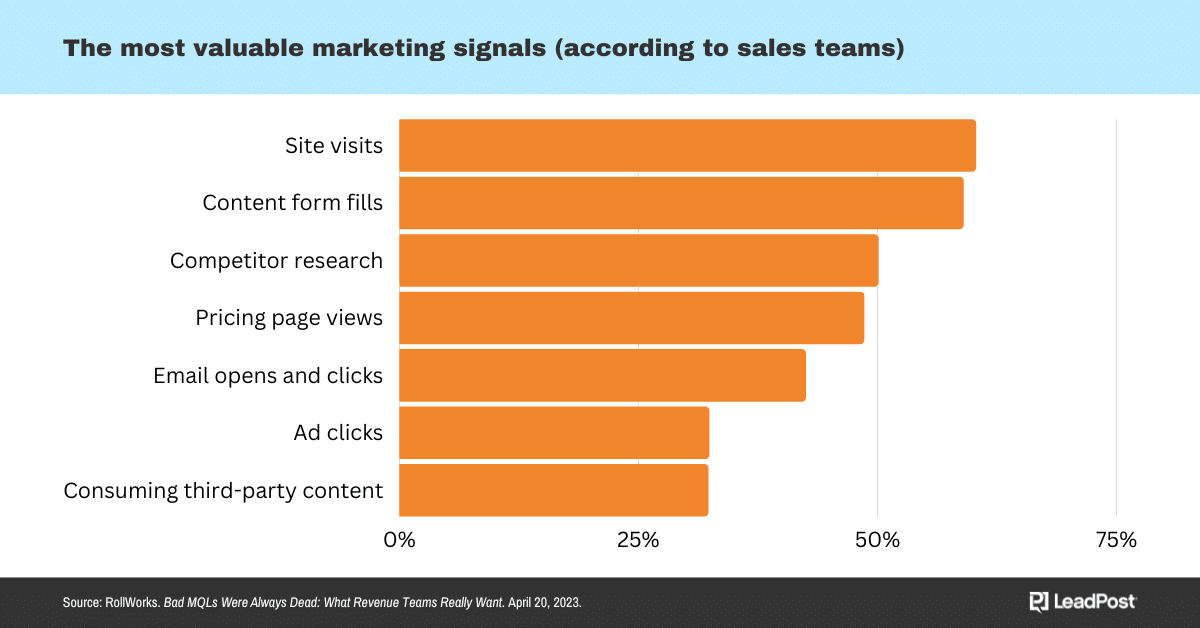Lead qualification is a critical component of lead generation. It ensures your sales and marketing efficiency. The first step is usually to identify marketing qualified leads (MQLs). But some say this is an outdated method.
There are other strategies to identify and nurture your leads that may be more effective. In this article, we’ll cover MQLs and alternative approaches.
Table of contents
The Importance of Lead Qualification
Qualifying leads allows marketing and sales teams to align their efforts. It streamlines their processes so they can focus on the most promising leads. That contributes to better customer experiences, higher conversion rates, and improved business outcomes.
What is a Lead?
A lead is an individual or organization that has shown interest in your products or services. They can express this interest in various ways.
Here are a few examples of how potential customers might show interest:
- filling out a form
- subscribing to a newsletter
- engaging with content on a company’s website.
What is a Marketing Qualified Lead?
An MQL is a lead deemed more likely to become a customer compared to other leads. You’ll make this determined by evaluating their engagement with your company’s marketing activities.
How to Choose MQL Criteria
MQLs have a higher level of engagement with your company compared to other leads. But what kind of engagement? You’ll need to look at historical data to make that determination.
For example, do more visits to your pricing page tend to precede a sale? Do visits to multiple key pages indicate greater purchase intent? Track your visitors’ website behavior so you can see what actions usually lead to a sale.
Use lead scoring and website visitor identification to help with this process. Website visitor identification software identifies anonymous visitors to your site who don’t convert. That way you can track their behavior.
Lead scoring automates the process of tracking these activities. It gives leads a score based on the actions they’ve taken. Then your team can rank them based on their score.
Your sales and marketing teams should work together to determine the scoring criteria. That will ensure that the leads marketing hands over to sales are truly ready for the next step.
How MQLs Fit into the Sales Funnel
MQLs typically fall in the middle of the sales funnel. They’ve expressed interest and engaged with your company’s marketing activities. This indicates a potential for conversion.
The goal is to nurture these leads. Provide them with information and support to move them further down the funnel.
Then, salespeople can concentrate their efforts on the leads most likely to convert. That improves efficiency and increases sales conversion rates.
What is an SQL?
A Sales Qualified Lead (SQL) is a lead that the sales team deems ready for the next step in the sales process. (That step is usually a direct sales push.)
It’s essential for marketing and sales to work together on determining what they consider an SQL. Sales will invest significant resources pursuing SQLs so you have to get it right.
MQLs vs SQLs
The main differences between MQLs and SQLs are:
- their position in the sales funnel,
- and who qualifies them.
MQLs are in the middle of the funnel and are qualified by the marketing team. SQLs are further down the funnel (closer to making a purchase decision). They are qualified by the sales team.
How to Identify MQLs
Here are a few approaches to identify MQLs.
Common Indicators that a Lead May be an MQL
Common indicators that a lead may be an MQL include:
- frequent interaction with the company’s website or content
- high email open and click-through rates
- active engagement on the company’s social media platforms
Modern technologies have made identifying MQLs more efficient and accurate.
Here are some of the key tools used in identifying MQLs:
- Marketing Automation Software. These platforms automate repetitive marketing tasks and track lead engagement across different channels. They capture information on email engagement, content downloads, page visits, and more. This data helps marketing teams score leads and identify those that qualify as MQLs.
- CRMs. CRM systems are essential tools in lead management. They help manage and analyze customer interactions and data throughout the customer lifecycle. This improves business relationships and assists in customer retention. CRMs can help teams track a lead’s journey, identify patterns, and flag potential MQLs for further engagement.
- Web Analytics. Tools like Google Analytics provide insights into how users interact with your website. These insights can help determine a lead’s interest level and whether they qualify as an MQL.
- Website Visitor Identification Software. This is a more advanced tool that goes beyond basic analytics. It actually identifies website visitors. Platforms like LeadPost identify your visitors even if they don’t fill out a form. This level of detail allows for more proactive engagement.
These tools can provide a comprehensive view of a lead’s behavior and engagement level.
It’s important to note that while these tools are essential, they are just part of the process. Identifying MQLs also requires well-defined lead qualification criteria. You’ll also need to have a good understanding of your target audience.
New Ways to Qualify Leads
Marketing Qualified Leads (MQLs) bridge the gap between marketing and sales teams. But the term has come under scrutiny in recent years. Some argue that it doesn’t reflect the complexity of the buyer’s journey in an increasingly interconnected and digital world.
The Rise of Account-Based Marketing and MQAs
As an evolution of the MQL approach, account-based marketing (ABM) emerged. It’s a strategic methodology that aligns sales and marketing efforts with key accounts. Instead of focusing on individual leads, ABM concentrates on a set of target accounts.
Marketers personalize campaigns to resonate with specific stakeholders within those accounts. This led to the birth of marketing qualified accounts (MQAs). This approach addresses the fact that buying decisions are often made by teams, not individuals.
Companies decide when an account is an MQA based on:
- Firmographic data. This determines how good of a fit is the company for the product or service on offer.
- Engagement. This helps evaluate how motivated they are to make a purchase.
The benefits of this approach lie in its ability to focus resources on accounts that show clear engagement.
Limitations of the MQA Approach
MQAs are a more holistic approach to account engagement. But critics argue they fall short in several respects. One of the main challenges with MQAs is that an account may contain opportunities at different stages.
An account could have multiple opportunities, each associated with different solutions and stakeholders.
Another limitation of the MQA methodology is “noise.” MQAs treat an account as a single unit. So marketers may struggle to extract actionable insights from their engagement data.
What if one group within an account is heavily engaged and another isn’t? The aggregate data could paint a misleading picture.
Opportunity-Centric Focus
Some experts advocate for an opportunity-centric focus instead. This approach is all about context. It takes into account each interaction that occurs with the potential buying group.
Marketing evaluates that information for insight into potential opportunities.
This puts emphasis on specific opportunities within an account instead of siloing leads or grouping all engagement under one account.
Limitations of the Opportunity-Centric Approach
An opportunity-centric approach certainly has its advantages. It focuses on potential deals, the buying group, and the context of interactions. However, it’s not without its downsides.
Here are a few potential downsides to an opportunity-centric focus:
- Complexity. An opportunity-centric approach requires a deep understanding of the buying group, their preferences, their behaviors, and their decision-making process. This requires a significant investment in data analysis and interpretation. That could be too complex for smaller organizations or those just starting out with their sales and marketing alignment efforts.
- Resource Intensive. This approach often demands extensive resources. That includes advanced CRM systems, marketing automation tools, and skilled personnel to analyze and interpret data. Smaller companies or startups might not have these resources readily available.
- Longer Sales Cycles. In an opportunity-centric approach, the focus is on the buying group as a whole. It takes each member’s engagement and interest into account before proceeding. That can potentially lengthen the sales cycle.
When to Go with MQLs or MQAs Instead
No approach is perfect. What works best will depend on your business.
Despite the emergence of MQAs and the opportunity-centric approach, MQLs still hold value. According to a study by RollWorks, 56% of marketers and 63% of sellers still value leads.

In particular, salespeople said they value leads qualified by the following criteria:
- Site visits (60.3%)
- Content form fills (59%)
- Competitor research (50.1%)
- Pricing page views (48.6%)
- Email opens and clicks (42.5%)
- Ad clicks (32.4%)
- Consuming third-party content (32.3%)
The opportunity-focused model might work great for your company. But there are circumstances in which an MQL or MQA focus might be a better fit.
Here are some examples:
- Simplicity and Efficiency. Does your business have a simpler sales process? Focusing on MQLs can be an efficient approach. Focus on individual leads that have shown interest in your products or services.
- Shorter Sales Cycles. Does the decision-making process involve fewer people or steps? Focusing on MQLs can be a better option.
- Resource Constraints. Are resources limited? Focusing on MQLs or MQAs might be more cost-effective. The tools required for an MQL or MQA approach are generally more affordable.
- B2C Businesses. Are purchases usually made by individuals instead of groups. An MQL focus could be more effective.
Ultimately, your approach will depend on your company’s specific circumstances. These include your sales process, resources, and the number of people involved in making a purchase decision.
And your approach may evolve over time as you grow. For example, you may eventually have more (or fewer) resources. Or you might gain a better understanding of your customer that leads you to change strategies.
It’s important to evaluate your lead qualification process regularly. Then you can make adjustments as necessary.
The Future of Lead Qualification
The lead qualification process continues to evolve. As businesses adapt to changing market dynamics and customer behaviors. MQLs, MQAs, and the opportunity-centric approach all offer distinct methods for nurturing leads.
Each approach has its strengths and limitations. The choice between them depends on your unique needs, resources, and strategic objectives. As the sales and marketing landscape continues to transform, businesses need to remain agile. So learn from past experiences and stay open to new strategies to stay competitive.
